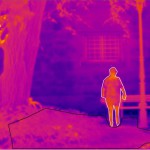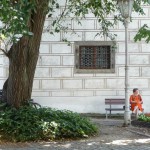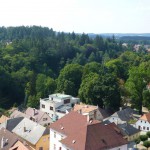How trees cool down towns in summer
Introduction
In the temperate zone during a clear sunny day the income of solar irradiance is about 1000 W m-2, which means that an area of 1ha gets up to 10 MW of solar energy. What happens with this energy depends on the availability of water and the type of land cover (2, 5). Most of the solar energy on dry surfaces is converted into sensible heat, which warms up the ground and the air above it (3). In summer, temperatures of such surfaces can exceed 50°C. However, if the surface is covered by functional vegetation (and well stocked with water) 70 – 80 % of the energy can be dissipated through water evapotranspiration (the sum of transpiration and evaporation), which means conversion into latent heat, responsible for landscape cooling (2, 6). As a consequence of the cooling effect of evapotranspiration, the vegetation cover well supplied with water is substantially cooler than adjacent dry surfaces. This can be conveniently documented by means of thermo-vision (4).
The aim of this poster is to demonstrate how trees may work as a perfect air-conditioning system driven by the solar energy and using water. We present several IR photographs of towns with adjacent tree stands in South Bohemia (Czech Republic), which clearly illustrate how vegetation cover in urban areas have a substantial effect on the local climate.
A tree and its air conditioning capability
Figure 1. The person standing in the shade of a tree in a park has a surface temperature of 25,1 °C, while the lawn under the tree has only 19,6 °C. Because the person is warmer than its surroundings it emits heat (long wave radiation) to cooler objects. In the contrary, a person standing on a pavement exposed to direct sunlight is about 10 °C cooler than the surroundings. Sealed surfaces of towns are uninhabitable, reaching temperatures of 50 °C or more.
Trees uptake water by their roots and the water then flows through the vessels in the trunk (sap) into leaves and evaporates via numerous stomata. A large tree can evapotranspirates several hundred litres of water vapour, using 0,7 kWh/L of energy for conversion of liquid water into water vapour (4, 5). The cooling effect is a result of the use of large amounts of solar energy. This energy is later released in cool air or on cool surfaces, where the evaporated water vapour then condensates. In this manner, the evaporation and condensation processes have a double air-conditioning function - plant stands are cooled in the evapotranspiration process while the places where the water vapour precipitates are heated. Evapotranspiration thus possesses a huge capacity to equalize temperature differences in time and space (1).
Figure 2. Overall view to Třeboň town square taken from the tower on a sunny summer day. Sun exposed roofs and pavement have surface temperature of more than 50 °C. Surface temperature of tall trees in adjacent park is 34,2 °C. Temperature of a parasol in outdoor restaurant is 46,6 °C.
Tree vs. parasol
What is the difference between the shade of a parasol and the shade of a tree? A tree not only reflects solar radiation (about 20 %) but also actively cools by water evaporation. A parasol on the other hand only reflects solar radiation (about 23 %) and is thus not as successful in cooling as the tree is. Therefore, a person sitting under the tree feels nice and cool whereas a person sitting under a parasol receives heat from the warmer surroundings.
Figure 3. A parasol over a person in a restaurant has a temperature of 51,3 °C while the temperature of the tree crown is only 32,7 °C. The area under the parasol is still quite hot, reaching a temperature of 36,3 °C (see also Fig. 2), whereas the lawn in the park has only 24,1 °C.
The role of parks in towns
Figure 4. Overall view to a part of Jindřichův Hradec town. Surface temperature of the trees in the park is about 35 °C whereas the temperature of adjacent buildings is more than 50 °C. The trees from the park the size of 1 ha cool with the efficiency of at least 3000 kW, which is equivalent to 1000 aircond units
Conclusion
Vegetation well stocked with water has a significant cooling effect and air-conditioning capability (3). Therefore, it is essential to bare its capacity for dissipation of incoming solar energy in mind – not only when managing the landscape in larger perspective, but also when making plans for rearrangement in the urban areas.
References
1- Čížková H., Květ J., Comín F. A., Laiho R., Pokorný J., Pithart D., 2011. Actual state of European wetlands and their possible future in the context of global climate change. Aquatic sciences 75: 3-26.
2- Hesslerová P., Pokorný J., Brom J., Rejšková – Procházková A., 2013. Daily dynamics of solar radiation surface temperature of different land cover types in a temperate cultural landscape:
Consequences for the local climate. Ecological engineering 54: 145-154.
3- Kravčík M., Pokorný J., Kohutiar J., et al., 2008. Water for the Recovery of Climate – A New Water Paradigm. Municipalia.
4- Pokorný J., 2001. Dissipation of solar energy in landscape – controlled by management of water and vegetation. Renewable Energy 24: 641-645.
5- Pokorný J., Brom J., Čermák J., Hesslerová P., Huryna H., Nadezhdina N. and Rejšková A., 2010. Solar energy dissipation and temperature control by water and plants. Int. J. Water 4: 311–336.
6- Pokorný J., Květ J., Rejšková A., Brom J., 2010. Wetlands as energy-dissipating systems. J Ind Microbiol Biotechnol 37: 1299-1305.
From the poster « How trees cool down towns in summer » by
This email address is being protected from spambots. You need JavaScript enabled to view it.
, ENKI, o.p.s., Dukelská 145, Třeboň 379 01, Czech Republic
This email address is being protected from spambots. You need JavaScript enabled to view it.
, Department of Biology, Biotechnical faculty, University of Ljubljana, Slovenia
















